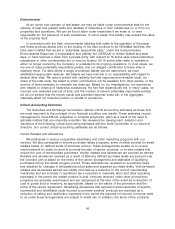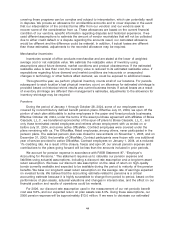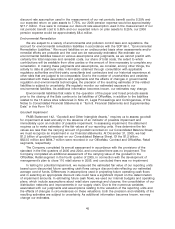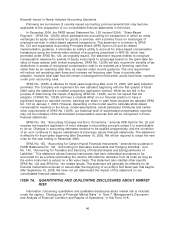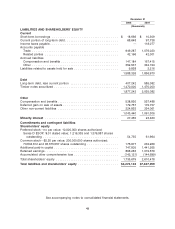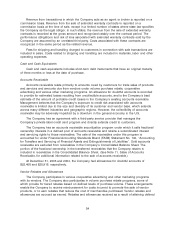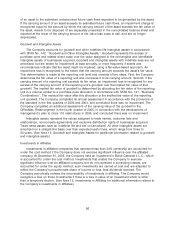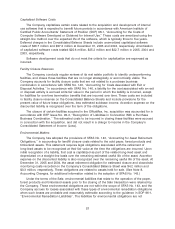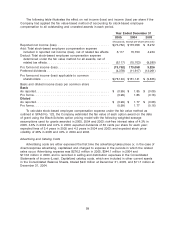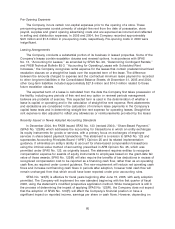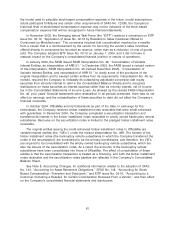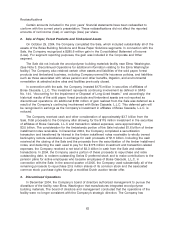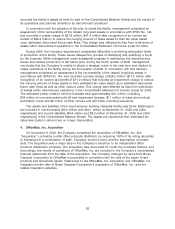OfficeMax 2005 Annual Report Download - page 57
Download and view the complete annual report
Please find page 57 of the 2005 OfficeMax annual report below. You can navigate through the pages in the report by either clicking on the pages listed below, or by using the keyword search tool below to find specific information within the annual report.Company’s international businesses have maintained their December 31 year-ends. The Company
consolidates the calendar year-end results of its international businesses in the fiscal year results.
Use of Estimates
The preparation of financial statements in conformity with accounting principles generally
accepted in the United States of America requires management to make estimates and
assumptions that affect the reported amounts of assets and liabilities and disclosures about
contingent assets and liabilities at the date of the financial statements, and the reported amounts of
revenues and expenses during the reporting period. Actual results are likely to differ from those
estimates, but management does not believe such differences will materially affect the Company’s
financial position, results of operations or cash flows. Significant items subject to such estimates
and assumptions include the recognition of vender rebates and allowances, the carrying amount of
property, plant and equipment, intangibles and goodwill; valuation allowances for receivables,
inventories and deferred income tax assets; store closing reserves and environmental liabilities;
valuation of assets held for sale; and assets and obligations related to employee benefits.
Foreign Currency Translation
Local currencies are considered the functional currencies for the Company’s operations outside
the United States. Assets and liabilities of foreign operations are translated into U.S. dollars at the
rate of exchange in effect at the balance sheet date with the related translation adjustments
reported in stockholders’ equity as a component of accumulated other comprehensive income
(loss). Revenues and expenses are translated into U.S. dollars at average monthly exchange rates
prevailing during the year. Foreign currency transaction gains and losses related to assets and
liabilities that are denominated in a currency other than the functional currency are reported in the
Consolidated Statements of Income (Loss) in the period they occur.
Derivative Instruments and Hedging Activities
The Company accounts for derivatives and hedging activities in accordance with Statement of
Financial Accounting Standards (SFAS) No. 133, ‘‘Accounting for Derivative Instruments and Certain
Hedging Activities,’’ as amended, which requires that all derivative instruments be recorded on the
balance sheet at fair value. Changes in the fair value of derivative instruments are recorded in
current earnings or deferred in accumulated other comprehensive income (loss), depending on
whether a derivative is designated as, and is effective as, a hedge, and on the type of hedging
transaction. Changes in fair value of derivatives that are designated as cash flow hedges are
deferred in accumulated other comprehensive income (loss) until the underlying hedged
transactions are recognized in earnings, at which time any deferred hedging gains or losses are
also recorded in earnings. If a derivative instrument is designated as a fair value hedge, changes in
the fair value of the instrument are reported in current earnings and offset the change in fair value
of the hedged assets, liabilities or firm commitments. The ineffective portion of an instrument’s
change in fair value is immediately recognized in earnings. Instruments that do not meet the criteria
for hedge accounting and contracts for which the Company has not elected hedge accounting are
marked to fair value with unrealized gains or losses reported in earnings.
Revenue Recognition
Revenue from the sale of products is recognized at the time both title and the risk of ownership
are transferred to the customer, which generally occurs upon delivery to the customer or third-party
delivery service for contract, catalog and Internet sales, and at the point of sale for retail
transactions. Service revenue is recognized as the services are rendered. Revenue is reported less
an appropriate provision for returns and net of coupons, rebates and other sales incentives.
53


